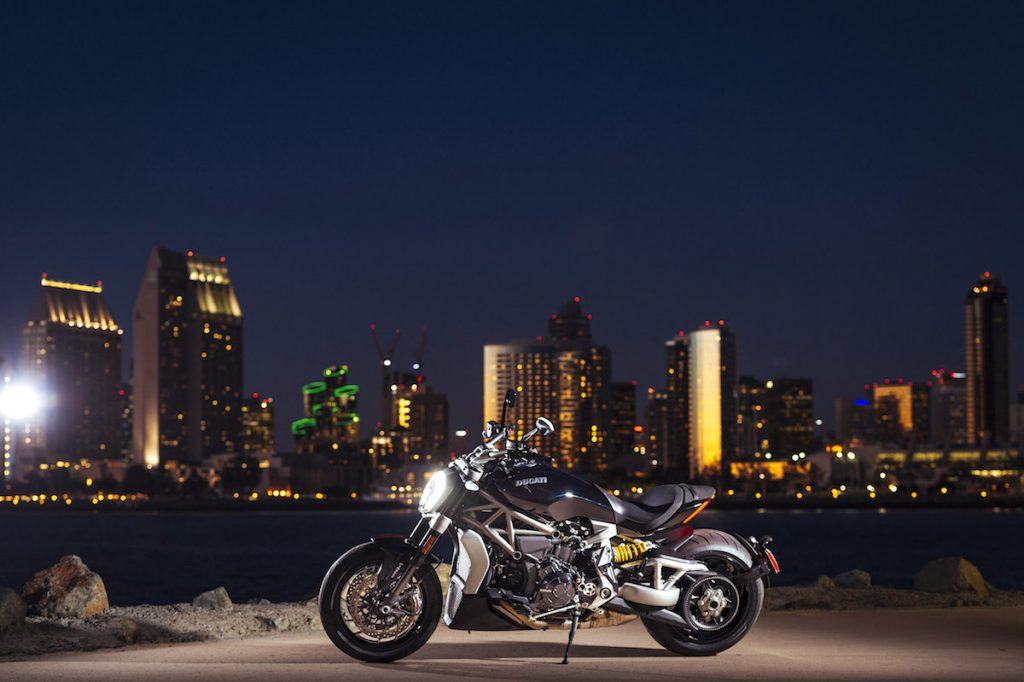AMCN was in SanDiego for the world launch of the Ducati XDiavel
The XDiavel is a completely new bike, a new motorcycling experience, and it doesn’t need all the theatrics for me to recognise and report that it is a truly brilliant piece of design. It has been engineered for maximum rider arousal and engagement, and delivers overall performance unparalleled in this market sector.
Ducati has been very clever in the way it has paved the way for such a massive departure from their core market. I can’t have been the only one to have copped a look at the first Diavel and thought, ‘What is it? And what is it for?’. Finally, though, it seems all has been revealed. ‘It’ was an experiment in shifting expectations of what a Ducati can be, and ‘its purpose’ was both to gauge and influence opinion. Gently ‘shifting the paradigm’ as Ducati explains.
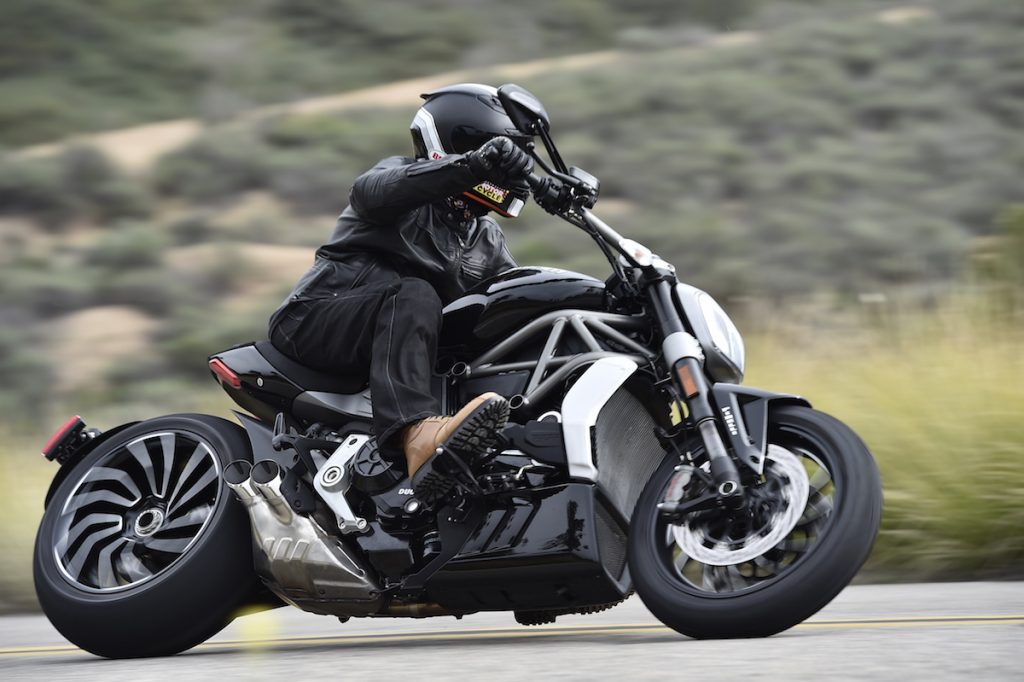
In recent times we’ve seen Ducati engage heavily in the art of selling dreams and lifestyles through marketing, in a way which has never previously been necessary for a brand with such a strong identity. Generally speaking, Ducatis have always sold themselves, because they have always been the ultimate Italian high-performance motorcycles. Ducati went racing, and then let our collective desires and imagination do the rest of the marketing for them. With the Scrambler and Diavel model ranges, the company has cast the net further than the realm of the life-long red-or-dead Ducatista, so it needed to create a new image with which to woo the Ducvirginal metropolites away from a potential life of DIY bobber and Harley-wannabe hell.
To help ease us into the new world of Ducati and create separate identities for each sector, the different personas have been colour coded into red for performance, yellow for retro, and black for bad ass. The XDiavel only comes in black, matte for the standard model and gloss duco for the top spec S model. So far 80 per cent of pre-orders worldwide are for the top shelf XDiavel S, and this says a lot about the target market. When you have the cash to splash on a lifestyle statement like the XDiavel, opting for the second shelf makes little sense. The only exception to the trend in forward orders from dealers is in the Scandinavian countries, where it’s expected most owners will customise their bikes heavily, creating something more personal, and probably spending more than the price of the S model overall in the process.

Rumbling quietly through the inner-city one-way system and out of San Diego central, the XDiavel instantly revealed itself to be light beyond its looks. There is obviously some kind of black magic playing tricks on your eyes when gazing over the bike, as it has a presence much larger than its physical size. There is no flop from side to side in the steering at low speed – a characteristic all too common on many conventional cruisers – and its turning circle is tighter than a spandex-wearing gnat’s chuff. Manoeuvring the XDiavel through city streets should come as an uncommonly enjoyable experience for long-term members of the feet-forward fraternity.
But low speed agility isn’t the only aspect of the XDiavel’s behaviour which is beyond the usual boundaries constraining feet-first throttle jockeys. Beyond the San Diego city limits, into the mountains bordering Mexico, and onto cambered and curvaceous roads which are usually the domain of scratchers and wannabe racers, the XDiavel unveils its most un-cruiser-like characteristic of all: this thing carves!
At the press briefing the night before our test ride, we were assured that Ducati’s high-performance principals were paramount in the design process. And even though the XDiavel is not your conventional performance model, these things are important to the Ducati ethos. All I can say is ‘well done fellas, good job!’
Gone are the days of pipe-grinding at barely past the vertical, and setting up for each corner a month in advance. This ‘cruiser’ will out-hustle any production easyrider on the planet, and make a mockery of many sportsbikes while it’s at it.
Producing a chassis package with sporty performance is something you’d expect Ducati to be capable of, even with the constraints of cruiser ergonomics. But to engineer such sharp handling with the double challenge of that phat-as-yo-mama’s-fanny 240-wide rear hoop is nothing short of a miracle. That’s a hell-of-a hunk of rubber hanging out the back and, surprisingly, apart from the brakes it’s the only part the new bike has in common with the old Diavel range.
Amazingly, bump-steer – an intrinsic problem of bikes with large differentials between front and rear tyre diameter, where rear wheel impacts while leant over cause the bike to stand up or veer off trajectory – is so minimal as not to be of any concern. Even corner turn-in defies all logic of how sharply a bike like this should steer. And rather than the expected understeer ploughing me wide in tight turns, if anything, once cranked right over on the edge of the tyre there is a touch of oversteer to deal with. Amazing!
But the XDiavel’s greatest gift to cruiser culture has to be freedom from ground clearance paranoia. With 40º of lean angle before its folding pegs skim and rise with the road, there is absolutely no good reason not to throw the XDiavel around like some new breed of lay-back café racer. So that’s exactly what I did.
The XDiavel’s performance is exceptional in the cruiser world, but its not all about un-cruiser like handling. It also goes and stops with brilliance beyond what any Milwaukee metal or back-yard bobber owner could ever dream of. This is a seriously well worked out and completed project, built with the intent of bringing all measures of performance to the party, not just the standard straight-line big V-Twin jollies that can be plucked from almost any motorcycle showroom these days.
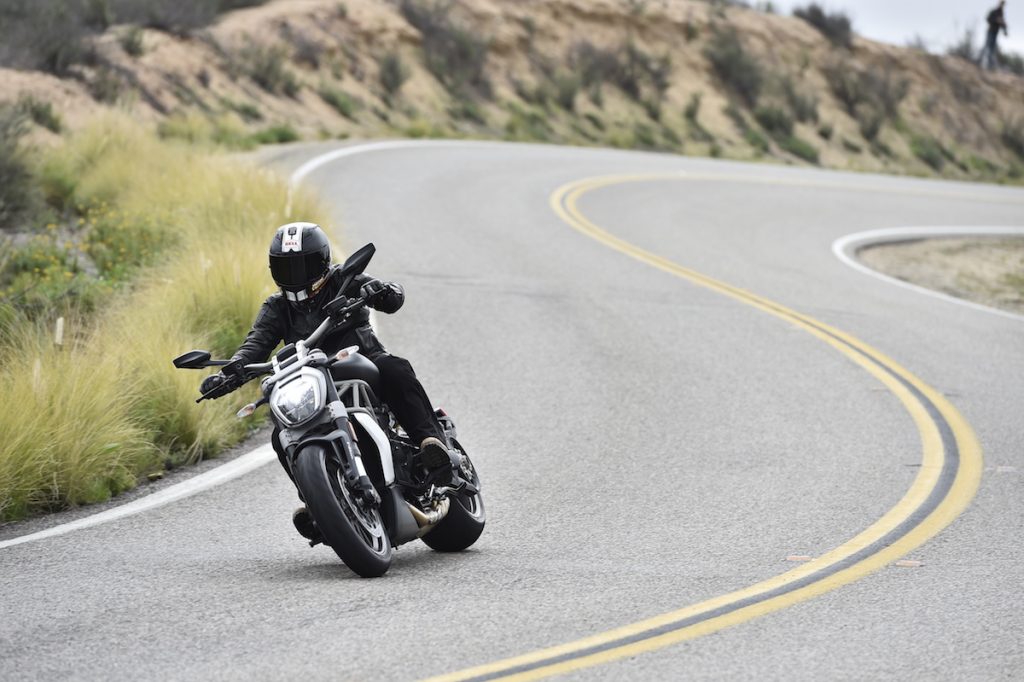
Dragstrip jollies haven’t been left behind though. In fact, there’s some new software in the XDiavel’s electronic armoury which is designed specifically to ace the traffic light race. Ducati Power Launch (DPL) promises to deliver ‘breathtaking – yet safe – starts’ every time. All you need to do is hold the throttle pinned and feed out the clutch gradually and the bike does the rest. There’s three different levels of launch lariness to choose from, and the system disables itself to let the clutch cool off if it senses you getting a bit carried away with the game. It even lets you know when you can start playing again, and how many launches you’ve got left before it calls shenanigans on the ‘GO!’ game again.
With all that rubber on the road it may be hard to imagine why you’d need the Ducati Traction Control system, but even a 240 section tyre needs a little help sometimes. XDiavel employs an eight level DTC, which operates with all the immediacy and refinement found on Bologna’s other glamour models.
Completing the thoroughly modern electronics package is the XDiavel’s very sporting brake system. Brembo provides the brawn – M4 32 radial monobloc calipers up front on the standard XDiavel, with M50 items being specced on the S model – and Bosch supplying the brains – with three-level full cornering ABS being enabled by Bosch’s own Inertial Measurement Unit (IMU).
The Bosch IMU also feeds information to the bikes ECU, which is used to adjust the bike’s behaviour under acceleration and braking in line with whichever riding mode has been selected. There are three of these – Sport, Touring, and Urban – and certain functions can also be customised within those modes. Being a full ride-by-wire system, with Ducati’s vast racing experience behind its development, it is hard to pick any faults. The XDiavel even goes one better than the Panigale range, in that the engine mapping for pulling away from a standing start is much cleaner.
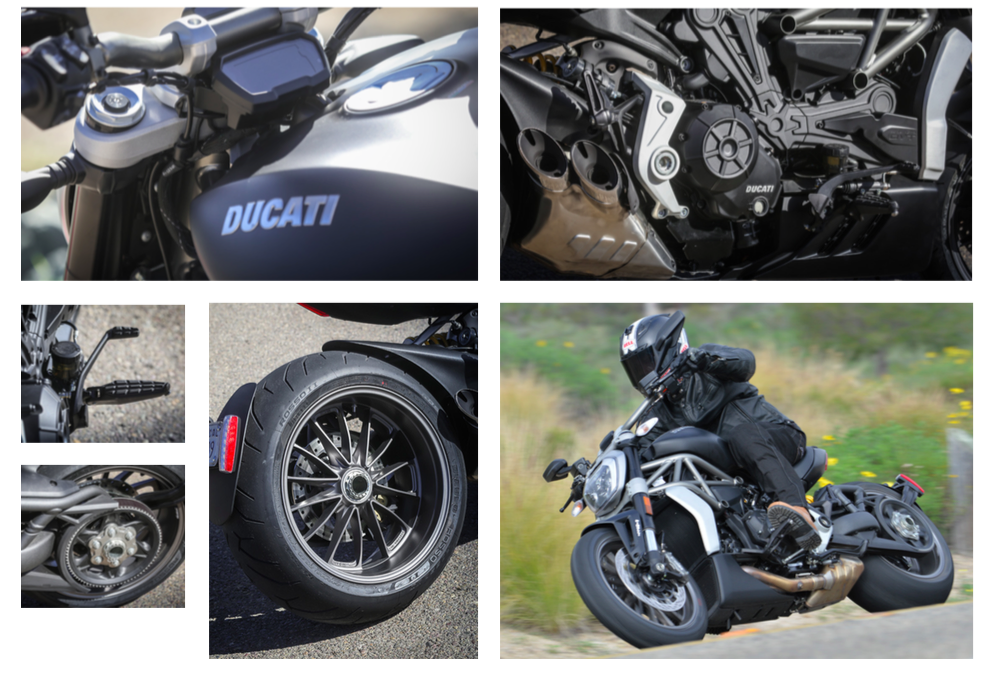
If there was one thing I could see missing from the electronics buffet laid out for XDiavel owners, it’s a quickshifter. If you are going to give the cruiser world a shake up with a full spread of superbike tech, why not just go the whole enchilada? It would be the cherry on the devil’s tart.
Besides featuring a feet-forward cockpit, the other Ducati first on the XDiavel is the belt final drive. The desired effect of quiet operation and smooth snatchless power transfer have been achieved, and if the estimated belt life of 50,000km is also correct, there’ll be a running cost benefit as well.
One of the reasons I’ve never been a big fan of some cruisers is the sensation of being a human wind sock when the speed gets to anything over 80km/h. It wears me out and makes my knackered back ache like buggery. The XDiavel had no such effect on me. The shape of the front end and tank seemed to do a great job of deflecting the worst of the wind straight over the top of my head, even at naughty speeds.
Its favourable airflow may have something to do with the fluid shape of the XDiavel. This new styling makes the original Diavel design look slightly clunky and disjointeded in comparison. Dare I say it, the XDiavel looks more ‘Ducati’ (something I struggle to describe the old bike as).
When the designers penned the XDiavel, they had a clear intent to provide an innate canvas for customisation, an environment in which major parts could be swapped or modified without disturbing the flow of the bike’s lines.
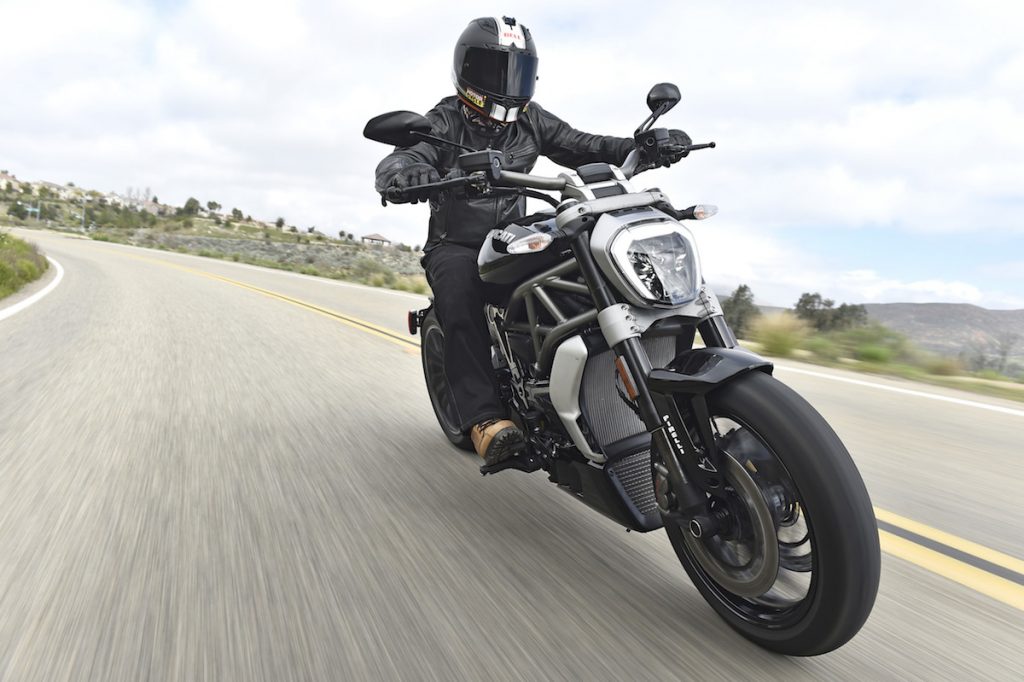
There is a lot going on with the XDiavel’s design, and the more you look the more thoughtful details emerge. Like the headlight – something Ducati holds key to creating the character of their bikes. The XDiavel’s is the shape of a cut jewel. A diamond in the rough-but-sexy if you will. Quality of detail can be seen everywhere. Even basic castings like the fork yokes are beautifully finished.
The only anomaly to this excellence in design execution that I could spot is the dodgy looking stepped section in the handlebars. It’s no surprise that Roland Sands Design’s XDiavel custom parts collection includes an anodised aluminium collar to redress this singular fashion faux pas. I’ll bet it was the first item on their hit list.
The motorcycle personalisation process isn’t all about motorcycle parts, though. It’s also about human body parts. None of us are exactly the same, so the XDiavel has been designed with a total of 60 potential cockpit layouts, enough to cover a majority of homo-semi-horizontalis shapes, using a combination of three alternative bars, five seating options, and four footrest positions, including a centrally mounted footrest kit for those who prefer the old Diavel’s sportier muscle-bike ergos.

Despite the frighteningly minute looking tail end, pillions are far from being an afterthought. Every XDiavel sold comes with a larger ‘comfort’ pillion seat and back rest which transforms the passenger perch from barely adequate to something much more secure than I’ve seen on any other bobber-style rear end. Clever, simple, elegant, and generous.
With my motorcycling background being firmly routed in racing, although I’ve immensely enjoyed riding many cruisers, I’ve never come away from the experience thinking this type of bike had a permanent place in my life, or warranted making room for one in my own garage. The XDiavel has broken new ground in bringing all-round performance to the cruiser genre, and this has in turn broken new ground in my opinions. If I had the means, there’d certainly be room for this kind of rolling theatre in my life.
By Paul Young
